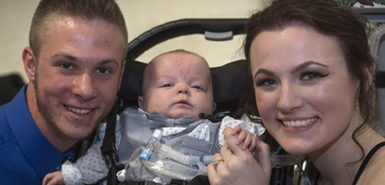Alison Mastin is a positive person, with negative blood.
She had no issues with her first child in utero, but her second pregnancy required monitoring.
Thankfully, no complications.
The third pregnancy? Not the charm.
“I knew the potential of having problems,” the Sparta, Michigan, resident said. “I started seeing a high-risk doctor at 16 weeks so they could measure how quickly the blood was moving through her brain via ultrasound. Based on how fast the blood was flowing, they could determine if she was anemic or not.”
Under attack
Normally, pregnant women who have Rh negative blood receive an injection of RhoGAM. Discovered in the 1960s, this medication prevents development of antibodies against positive blood types.
Prior to that time, women with Rh negative blood had a 14% chance of having a stillborn baby and a 50% chance of a live birth resulting in the baby’s death or brain injury.
Mastin received RhoGAM during and after her first pregnancy. Then she found out early in her second pregnancy that she’d developed antibodies against both C and D antigens, which posed a risk in her third pregnancy to her unborn daughter, Violet.
At 28 weeks, the risk became real.
Violet’s blood started moving faster, indicating trouble. The antibodies in Mastin’s negative blood were attacking Violet’s positive blood, causing fetal anemia.
As a Spectrum Health nurse practitioner, Mastin worked with pediatric patients with blood complications. Her work and personal life collided as she and her unborn baby’s blood battled.
Vivian Romero, MD, Spectrum Health Medical Group maternal fetal medicine specialist, took action.
“Her anemia level had gotten to the point that we needed intervention,” Mastin said. “They had to give Violet an intrauterine blood infusion. Dr. Romero was able to locate the umbilical vein and put a spinal needle into the vein.”
A nurse served as a runner to take Violet’s blood samples to the lab to determine her hemoglobin levels in real-time.
“They needed to know how much to use for her little body,” Mastin said. “Dr. Romero had written on a piece of paper all the different levels so she knew exactly what specific volume she would need.
“Slowly, she pushed it into the umbilical vein right to Violet,” she said. “I knew that I needed to stay completely still and knew how important this was, but it was so uncomfortable. And I was so nervous.”
Dr. Romero, who said severe fetal anemia is rare, repeated the procedure two more times—every three weeks.
“Fetal anemia occurs when there is a decrease in the baby’s red blood cell count before delivery,” Dr. Romero said. “Red blood cells are necessary to carry oxygen to the organs of the developing baby.”
Severe anemia can lead to heart failure, fluid buildup and even death.
“The most common reason for fetal anemia occurs when the baby has a specific difference in blood antigens or proteins from the mother,” Dr. Romero said. “This happens when the baby inherits certain blood antigens from the father that the mother does not have. The mother’s system can create antibodies that attack the fetal cells.”
Toughing it out
Dr. Romero said Violet’s fetal response to the “attack”—speeding up the blood flow to the brain—is a common one.
The doctor used ultrasound to guide her during the blood sample procedure.
“When fetal anemia is suspected, a true diagnosis can be made only by sampling blood from the umbilical cord of the baby,” Dr. Romero said. “If fetal anemia is confirmed, an intrauterine transfusion is given to the baby to replace fetal red blood cells that are being destroyed.”
With Dr. Romero’s help, Violet toughed it out in the womb.
“Our goal was to just get her to term,” Mastin said. “At that point, Dr. Romero felt it would be safer to deliver Violet at 37 weeks.”
At 4 p.m. Nov. 8, 2018, Mastin and her husband, Brian, met their baby girl.
“I was induced and she came pretty quickly,” Mastin said. “Everything went smoothly and she looked great. They did have a neonatologist there to make sure things were OK. Physically she looked great.”
Mastin and Violet spent an hour cuddling.
“After that hour, you could tell her skin was becoming jaundiced,” she said.
The team checked Violet’s bilirubin and decided she needed phototherapy, a special light therapy that helps jaundiced babies. Violet spent six days at the NICU in the Gerber Foundation Neonatal Center at Helen DeVos Children’s Hospital for the light therapy. She didn’t need a blood transfusion.
On Nov. 13, Violet joined her family at their Camp Lake home. Her siblings, Brody, 7, and Jessa, 4, fell in love with their little sister.
“They just adore her,” Mastin said.
Violet later needed several blood transfusions, but now has no signs of anemia. In January, she graduated from the hematology clinic.
“Since then she’s been great,” Mastin said. “Her hemoglobin is holding its own. We don’t have to go back to the hematology clinic.”
Summer love
On a recent summer day, Violet sat on Mastin’s lap at their lakefront home.
Violet looked up at her mom with big, blue eyes and smiled.
“What a special girl you are,” Mastin said, looking down at her daughter. “We’re just having fun watching her grow.”
The family also has fun swimming and boating. And just hanging out.
“Violet loves me,” Brody said. “Mom, can we have 10 more kids?”
“Violet loves me, too,” Jessa said.
Mastin smiled at her family and kissed Violet on the cheek.
“You guys are good big brothers and sisters,” she said.



















 /a>
/a>
 /a>
/a>
 /a>
/a>
My fraternal twin boys will be 53 years old October 8. It wasn’t known until they were born that David had my blood type, RH- and his twin brother Craig’s was positive! They were healthy and a normal birth. Is this an unusual situation? Just curious after all these years! I would appreciate a comment by Dr. Romero. Thank you!
Hi Mrs. Bruckman,
It not a common condition because 85% of the population is Rh positive. Since you are Rh negative your pregnancy could have been affected.
However, it typically presents in the second pregnancy because your blood had to be exposed to the Rh positive antigen (usually after first delivery of the first baby had Rh positive blood) to be able to create an immune response and produce antibodies. It also depends on the immune response (antibodies) produced. If the response is severe it is more likely to cause fetal anemia.
Certainly, Rhogam has saved many lives by avoiding the production of these antibodies in Rh negative mothers but it wasn’t available until 1968.